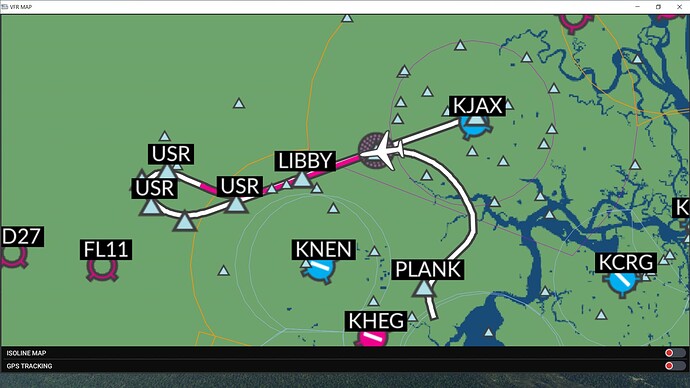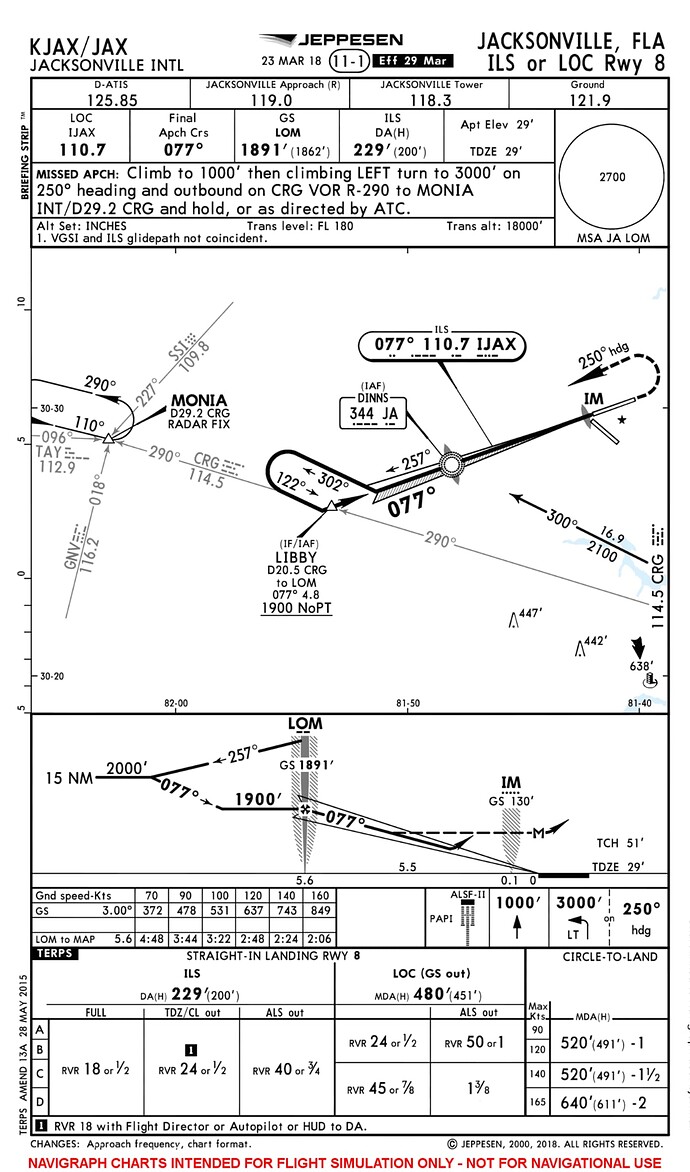How does MSFS generate ILS approaches? I’m not one to download real life approach charts, I depend on the sim to generate a halfway decent approach. But some of them like the one here are just ridiculous. If I fly this and ATC tells me to descend to 2000ft before reaching Libby on the first past well, I’m just going to be in the flight path of other aircraft on final. I sure hope at some point we get a major flight planner and ATC overhaul.
Moved to #self-service:atc-traffic-navaids
The stock sim engine does not understand all AIRAC Leg and Procedure types. Only the Working Title NXi, CJ4 and select third party planes implementing their own FMS using Working Title open source FP Engine correctly implement and fly these procedures.
Your best bet now is to be using a plane that has one of the above FMS, and plan the flight using an AIRAC compliant EFB such as Little Nav Map or Simbrief. Then export to a .PLN.
Even then, all plans will still need to be loaded INTO the stock sim planner in order to sync ATC (so that their “control” and prompts match your intended plan). So the depiction on the World Map and by extension, the VFR in-flight map will continue to show defects. However, if using an AIRAC compliant FMS, the plan will be respected, including proper projection turns, course reversals, Missed Approach (assuming the FMS supports MAs).
Long term, you need to wait until Working Title refreshes enough FMS in the stock sim to be AIRAC compliant. At which point, that “critical number” makes it possible for them to replace the current Flight Planning Engine with their own. When that happens is not declared publicly by WT. Simply Soon™.
What approach did you select? If you selected the ILS rwy 8 with JA as the IAF it looks pretty much as it should (unless your concern is the curved leg rather than a straight leg getting you from PLANK to JA), except maybe the procedure turn is a bit far out. If you select the ILS RWY 8 with LIBBY as the IAF you should get a more straight in approach without the procedure turn.
This looks like KJAX ILS Rwy 8 approach. And it appears to match the approach plate. That is, MSFS implented this approach according to the chart.
And it looks like the outbound altitude at Libby is 2000 ft and inbound after the PT is 1900 ft. ATC keeps other aircraft away…
Not sure about any other issues about this approach…
Yes, it is the ILS RW8. It must not be a busy airport because you could never have a plane fly one way at 2000ft and other planes flying the other way at 1900ft at Libby. No way could you have an approach at a busy airport like KMCO where planes line up one after another on approach.
You aren’t going to be flying a procedure turn to reverse direction at an airport as large as JAX. ATC is going to give you vectors to the final approach course. But IRL, the lost comms rules allow the pilot to fly the approach of his choosing as published if none has been previously assigned or told to expect. In the image you posted you are starting at PLANK. From there it’s a left turn to the IAF at DINNS and another left toward the IF at LIBBY. Before you get to LIBBY you turn to a heading of 302 to start the procedure turn. All the while, ATC is going to be clearing the airspace for you.
The sim doesn’t do approach vectors. At least not that I have seen. What you get are the published procedures.
Not sure what your definition of “busy” is. Generally the FAA doesn’t staff ATC towers at low-traffic airports. KJAX averages about 196 flights per day according to the FAA. KMCO being a much larger airport averages about 1006 flights per day pre-COVID.
ATC manages and sequences incoming IFR traffic flow to busy airports using published arrival procedures (STARs) keep aircraft separate. This is not just to prevent conflicts but also for avoiding wake turbulence (not yet simulated in MSFS). IRL an airliner can be flipped over by wake turbulence if they are following too close while flying an approach. ATC manages departing traffic using standard and obstacle procedures (SIDs and ODPs) again to prevent conflicts and for avoiding wake turbulence.
Also, IRL if a pilot thinks an approach or any charted procedure is too dangerous, it can be anonymously reported to the FAA. When the FAA changes a charted procedure, it will be updated in MSFS when a navigation database update is received.
Well there’s your problem. I’m an instrument-rated pilot, and just by looking at the graphic you posted, that’s a course reversal. The issue is that from the direction from which you are coming, you wind up inside the final approach fix when intercepting the inbound course on the ILS. (Probably because of the airspace around KNEN). So what the approach has to do is get you turned around and back inbound to the airport on the approach. What you see here is not at all uncommon.
As far as in-game ATC goes, you may as well just forget about it. I would call it a joke, but it’s not a joke, because jokes are funny.
If it helps here is how I look at it.
Radar vectoring is not supported by in-game ATC. Therefore, we have at least four options:
- Fly as if there is no radar IRL. That means flying full procedures, hopefully with a STAR or feeder bringing you to a good place on the approach without a lot of extra track miles but sometimes resorting to a procedure turn like in the OP’s example. Realistic in some ways, except we usually would have radar.
- Fly the flight paths that would be used IRL. That means “self-vectoring” (eyeballing the flight path on a moving map) in case the real-life procedure would have involved radar vectoring. Not something you would do in real life so it feels weird to me.
- Use something other than in-game ATC to provide vectoring, but that comes with other issues.
- Just fly whatever the in-game flight planner gives you and use GPS to follow it. Requires the least forethought and planning.
I prefer the first method myself, sometimes resorting to the second method if there is no other reasonable option. But I can see the benefits of all four methods.
And that is my biggest issue with MSFS ATC… You are forced to fly approaches as published. Prepar3D will vector you all the way to the runway. I don’t quite understand why MSFS doesn’t do it, considering its ATC is almost an exact copy of P3D’s ATC except with less usefulness.
Because the flight planning engine, upon which ATC is overlaid, is not 100 percent AIRAC compliant. Until WT fixes that first, then ATC gets “smarter.”
Vectoring has nothing to do with being AIRAC compliant. The whole point of radar vectoring is that there is no need to follow defined routes or leg types. Vectoring worked for almost two decades in MSFS ATC until it for some unfathomable reason was overlaid on the flight planning engine. That is what broke it and uncoupling the two is how to fix it.
Vectoring doesn’t work now - however the code logic is working, it can’t even get the player to an Approach;s IAF. So I’m not certain that it’s as simple as uncoupling the two. If nothing else, they actually need to be more closely integrated.
I completely agree with you it is not the uncoupling alone that makes it work. My point is that vectoring to an IAF or FAF will never follow the flight planned route, except by extremely unlikely coincidence, so the problem of fixing vectoring is uncoupled from the problem of improving flight planning functionality.
Same as in real life, the solution is to vector the aircraft off the flight planned route and onto the correct leg of a pattern defined around the arrival runway and ending with a 30 degree intercept leg to the FAF or an equivalent point on the extended runway line. That might seem like a challenging problem, but since it worked in the past it can be made to work again by simply reverting to how it was done before.

